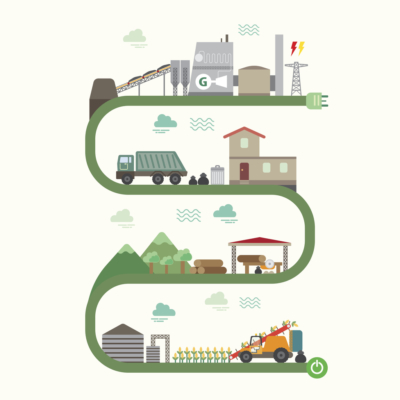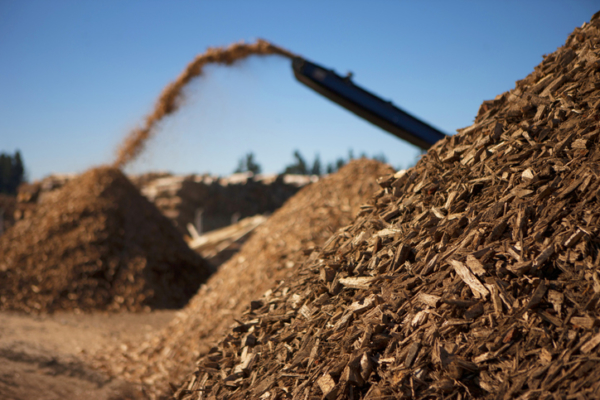If you’re interested in learning about biomass energy, then you’ve come to the right place. In this comprehensive article, we’ve provided thorough answers to the following common questions:
- What is biomass energy?
- What are the different types?
- How is it generated?
- What can it be used for?
- How does biomass energy affect the environment?
If you’d like to learn more about different forms of renewable energy and other topics oriented around improving the world we live in, be sure to check out the rest of our blog and our eco-friendly energy plans.
Let’s begin!
What Is Biomass Energy?

Biomass energy is a type of renewable energy that can be drawn from organic materials. Biomass can either be burned or converted into liquid or gas form, which forms are called biofuels and biogas.
What makes this energy so accessible and renewable is the long list of materials that the energy is drawn from. Plants, garbage, wood, and other forms of common waste can all be used to harness this energy, which makes for a method that can be continuously used without depleting its source.
While this form of renewable energy isn’t as popular or as widely known as solar and wind energy, it is one of the oldest forms of energy known to man.
How Is Biomass Energy Produced?

The first step in generating biomass energy happens organically and involves the plants and the sun. We all remember learning about the process of photosynthesis in our middle school science class, right? Plants contain chlorophyll, and the chlorophyll in every plant is capable of harnessing the sun’s energy to convert carbon dioxide into complex carbohydrates. These carbohydrates are composed of oxygen, carbon, and hydrogen. Once these compounds are burned, they transform back into their original state, releasing the sun’s energy that they harnessed in the process.
While this form of energy begins with the plants, it is capable of transferring from plants to animals to animal waste. Because this energy is able to move down through the food chain without being released, there are many different options available when it comes to burning organic matter in order to produce biopower.
To summarize, biopower can be produced by burning organic materials in order to obtain the energy these materials harvested from the sun’s rays. For this reason, biomass energy is considered a renewable energy source.
5 Types of Biomass
As we’ve mentioned, the list of materials that we can burn for energy is quite long. For this reason, organic materials used to generate biopower are divided into five main categories: garbage, landfill gas, alcohol fuels, wood, and crops. Below, we’ve elaborated on each different type of biomass.
Wood

Wood is a widely-used form of biomass to collect energy from. According to The National Energy Education Development (NEED), wood makes up for nearly 45% of all biomass energy today. This can come in different variants that include whole logs, bark, wood chips, and even sawdust.
This particular source of biopower is commonly used to generate heat. Have you ever sat around a campfire or warmed your house with the help of a wood-burning fireplace or furnace? If the answer is yes, then you’ve used biopower.
Wood can also be burned to create electricity, although this process isn’t as simple as burning wood to heat a home or building. When generating electricity, wood or wood waste must be burned in a boiler to create heat that is concentrated on raising the temperature of a water supply. Once the water converts to steam, the steam is capable of rotating turbines that generate electricity. Using steam to create electricity is referred to simply as steam power.
This method, of course, doesn’t come without a drawback to balance the advantages. The amount of wood required to generate a significant amount of energy can be substantial. If this form of biomass energy is too heavily utilized, it does have the potential to contribute to deforestation.
Garbage
One great way to derive energy from steam is by burning garbage — or municipal solid waste. Instead of stocking the boilers with wood, this method involves filling the boilers with trash instead. This type of biomass energy is generally harvested at a waste-to-energy power plant in large amounts at a time.
We mentioned before that biomass has to do with burning organic materials, but this isn’t always the case when it comes to burning waste in order to produce energy. A great deal of trash-produced biomass energy comes from various forms of plastic, which contain natural gases and petroleum.
While municipal solid waste doesn’t produce as much energy as coal does (about 2000 pounds of garbage equates to 500 pounds of coal) it does have a lot of potential in reducing the amount of trash buildup on our planet, wouldn’t you agree?
Even though it sounds like a good idea, this particular method has been slow to pick up any real momentum. According to The U.S. Energy Information Administration, less than 13% of the nation’s municipal solid waste (262 million tons) was used to generate biomass energy. The hope is to eventually get this technology and process to point of great use and efficiency in the near future to make it more useable.
Incinerating trash poses a long-standing debate between environmentalists and…well, the people who want to burn trash. The argument is that the waste-to-energy plants generate far more pollution than they’re worth, particularly for surrounding communities and wildlife.
Crops
Yes, even crops and agricultural waste can be used to generate biopower. Things like corn cobs, fruit pits, and other variants of food waste can be transformed into ethanol, which can be used to fuel vehicles and certain types of machinery. A combination of vegetable oils and animal fat can be converted into biodiesel, which can also be used to fuel vehicles.
As is the case with wood-fueled biopower, this particular method cannot be too heavily relied on without consequences. As the demand for renewable energy increases, the utilization of crops and other agricultural sources must be monitored and restricted, or we could be competing with our own food resources.
Landfill Gas
Landfills loaded with garbage are also commonly loaded with bacteria and fungi that are capable of slowly decomposing the trash by converting cellulose to sugars. As the garbage rots and decays under the influence of the fungi and bacteria, methane gas is produced.
While methane gas can be dangerous in other situations, it can be put to good use when it’s capture at a landfill. Once the methane gas is collected, it can be purified and used as fuel. Although this type of biomass energy is much slower than the rest, it still serves as a sustainable and renewable form of energy.
Alcohol Fuels
Through a wide variety of different organic materials and methods, we can convert trash into alcohol fuel such as ethanol and biodiesel. Biodiesel is a great way to make use of the oil and grease that doesn’t decompose or evaporate over time. By combining alcohol with different oils, fats, and recycled grease, we can create biodiesel and use it to fuel unmodified diesel engines.
Environmental Effects of Biomass Energy
As far as environmental effects are concerned, biomass energy has its fair share of positive and negative outcomes. While the biopower itself emits fewer greenhouse gases than traditional fossil fuel, the production of such energy still produces an amount of pollution that should be taken into consideration. The incineration of municipal solid waste, for example, is a point of environmental controversy because it has the potential to reduce the nation’s trash buildup, but not without consequential pollution.
Recent research suggests that measures are already being taken to reduce the social and environmental impact of biomass energy. With the development of next-generation biofuels, experts predict an improvement in the amount of pollution emitted, as well as cheaper, more abundant feedstock and lesser land requirements.
The scales are currently held in a fair balance for the major forms of biomass energy, but we’ll just have to see what changes can be made to reduce pollution while harvesting sustainable energy forms.
Do More For the Environment
Are you looking for more ways to contribute to a greener earth and cleaner air? Spring Power & Gas offers eco-conscious energy plans for the consumer aspiring to live a more sustainable lifestyle. Sign up today!




![Top 11 Sustainable Building Practices for Eco-Homes [Plus 5 Sustainable Materials]](https://springpowerandgas.us/wp-content/uploads/2023/02/iStock-181062267-500x383.jpg)

